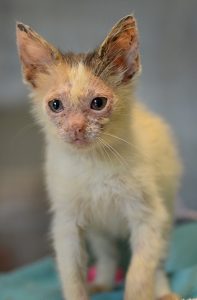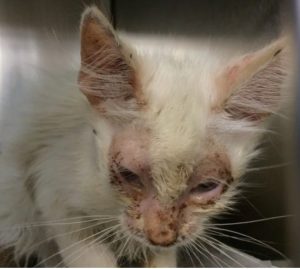Module 4: Healthcare practices for common contagious infectious diseases
Ringworm

Dermatophytosis or “ringworm” is a common skin disease in shelter cats caused by the dermatophyte fungus Microsporum canis. M canis is a zoophilic dermatophyte that requires keratin in hair shafts and follicles for survival and replication. Ringworm is an important skin disease because it is contagious between animals and can be transmitted to people. Ringworm represents a significant and frequent drain on shelter resources, including treatment costs, staff time, and staff morale. Holding cats for treatment and recovery adds to the number of animal care days until adoption, which in turn impacts the housing capacity for the shelter and contributes to crowding and more disease spread.
Review the Feline Ringworm Infections in Shelters document to learn the about the properties and clinical features of M canis infections, diagnostic tools, and strategies for management and prevention in shelters.
Key Takeaways for Feline Ringworm Infections in Shelters
- Feline ringworm is caused by the dermatophyte fungus Microsporum canis.
- Kittens are the most susceptible to M. canis infection, especially those with concurrent infections such as URI and parasites.
- Ringworm outbreaks due to M. canis commonly occur in the summer and fall (“kitten season”).
- The primary route of M. canis transmission is direct contact with an infected cat.
- Skin lesions typically appear within 7 to 14 days after infection (incubation period).
- Typical skin lesions most often appear on the face, ears, and legs/feet.
- The best diagnostic approach is to use a combination of diagnostic tools, including Wood’s lamp exam, trichograms, fungal culture, and PCR.
- Infected cats and in-contact cats should be isolated to reduce risk for transmission to other cats and people.
- Although ringworm infections eventually resolve, treatment shortens the course of disease to 4 to 6 weeks.
- Successful treatment requires concurrent use of systemic oral antifungals, such as itraconazole or terbinafine, and topical disinfection of the hair coat with lime sulfur dips.
- Clinical cure commonly precedes mycologic cure.
- “Fomite” or “dust mop” cats have no skin lesions but are positive on diagnostic tests due to carriage of fungal spores in their coat. These cats are not truly infected and should be treated once with a lime sulfur dip to kill the spores on their coat. After the dip, they do not need to be isolated.
- The most important part of decontamination in a ringworm ward is daily mechanical cleaning to remove spore-contaminated hair and dander.
- Rescue (1:16) and Trifectant (2%) are the best disinfectants to use for ringworm environments, including cages and floors and countertops.
- There is no vaccine for ringworm. Prevention relies on effective population management strategies to divert kittens to housing options other than shelters and to shorten the length of stay for those that enter the shelter.
Ringworm Risk Factors
Risk factors for ringworm include young age, warm humid environment, concurrent systemic diseases, stress, and overcrowding. Kittens are the most susceptible to M. canis infection. A recent study found that kittens <6 months old had 8X greater risk for infection than adult cats. Debilitated kittens with concurrent URI and parasitic infections are at most risk for ringworm.

Cats from large-scale hoarding environments are also at higher risk for ringworm. Cats with FIV or FeLV infection do NOT have increased risk for infection.
Ringworm outbreaks due to M. canis commonly occur in the summer and fall (“kitten season”) when large numbers of kittens are admitted to shelters and kept in stressful high density housing areas. This is also the time when the incidence of URI is highest.
Ringworm Transmission
The primary route of M. canis transmission is direct contact with an infected cat. Infection from contact with environments contaminated by fungal spores is rare. Key to establishment of infection is damage to the skin because healthy skin is a natural barrier to infection. Skin can be damaged by ectoparasite infections, URI discharges from eyes and nose, and diarrhea.

